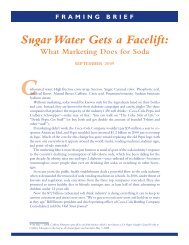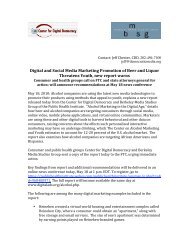"Interactive Food & Beverage Marketing" (PDF)
"Interactive Food & Beverage Marketing" (PDF)
"Interactive Food & Beverage Marketing" (PDF)
You also want an ePaper? Increase the reach of your titles
YUMPU automatically turns print PDFs into web optimized ePapers that Google loves.
16<br />
<strong>Interactive</strong> <strong>Food</strong> & <strong>Beverage</strong> Marketing | Setting the Stage<br />
More recently, the Henry J. Kaiser Family Foundation’s 2006 report, It’s Child’s<br />
Play: Advergaming and the Online Marketing of <strong>Food</strong> to Children, examined websites<br />
sponsored by food manufacturers promoting popular brands among children, finding that<br />
“the vast majority (85%) of the leading food brands that target children on TV are also<br />
either directly targeting children on the Internet or providing online content likely to be of<br />
interest to them.” By providing vivid documentation of these “branded entertainment”<br />
sites, the Kaiser study has helped shed light on some of the practices that have become<br />
commonplace in digital marketing, including “advergaming,” viral marketing, media tieins,<br />
and extensions of online experiences into “offline” outlets. 38<br />
But these studies reveal only a tiny part of a complex and extensive global digital<br />
marketing enterprise that has important implications for the health of America’s children.<br />
As the media marketplace continues its rapid transformation, becoming a ubiquitous<br />
presence in young people’s lives, the public remains largely unaware of the nature,<br />
scope, and extent of its influence.<br />
This report is a first step in articulating the nature of this new digital marketing<br />
environment. The report has three main objectives:<br />
1. to provide an overview of the key developments that are shaping the new digital<br />
marketing environment, with particular attention to the targeting of children and<br />
youth;<br />
2. to identify the major contemporary strategies used by food marketers to promote<br />
their brands to children and adolescents, including the targeted efforts to<br />
reach multicultural youth; and<br />
3. to offer recommendations for further research, public education, corporate initiatives,<br />
and policy interventions.<br />
This descriptive report is based on detailed examination and analysis of developments<br />
in the digital marketplace, in order to develop a deeper understanding of its<br />
structure and direction, and to identify the key practices that are emerging to target children<br />
and adolescents. We have relied on a variety of resources, including media and<br />
advertising industry white papers, trade publications, conference transcripts, proprietary<br />
reports, and other documents. To research the ways in which major food and beverage<br />
companies are marketing their products to young people in the digital media, we examined<br />
the companies’ own public documents and press statements, augmenting this information<br />
with analyses of websites and other content available online. 39<br />
Recently, the food industry has told regulators that it has decreased the amount<br />
of money spent on advertising to children. 40 But such claims fail to acknowledge the fundamental<br />
changes that are blurring the lines between advertising, marketing, and brand<br />
promotion. It is no longer possible to isolate ads or commercials as discrete forms of selling<br />
to young people. For that reason, we will use the broader term “marketing” to<br />
describe the wide range of practices that food companies use to promote their brands.<br />
In many ways, the digital strategies used by food companies* are not that different<br />
from those of other corporations targeting young people, and the report will lay out a<br />
broad picture of the nature of this new marketing infrastructure and its dominant practices.<br />
But as the following pages will show, in the case of food marketing, some of these<br />
practices raise serious issues that deserve close scrutiny and prompt, remedial action by<br />
policymakers and the public.<br />
* We use “food companies” in this report to refer to both food and beverage marketers.









